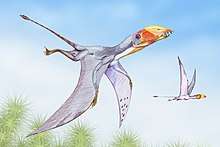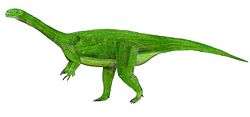Hanson Formation
The Hanson Formation is a geologic formation on Mount Kirkpatrick, Antarctica. It is one of only two major dinosaur-bearing rock groups found on the continent of Antarctica to date; the other is the Snow Hill Island Formation and related formations from the Late Cretaceous of the Antarctic Peninsula. The formation has yielded only a handful of Mesozoic specimens so far and most of it is as yet unexcavated. Part of the Victoria Group of the Transantarctic Mountains, it is below the Prebble Formation and above the Falla Formation.[1] The Formation is related to the Volcanic Activity Linked to the Karoo-Ferar eruptions on the Lower Jurassic.[2][3][4] The climate of the zone was similar to the modern Southern Chile, Humid, with a temperature interval of 17-18 degrees.[5]
| Hanson Formation Stratigraphic range: Late Sinemurian-Lower Pliensbachian ~194–188.5 Ma | |
|---|---|
 The Hanson Formation is located on the Transantarctic Mountains | |
| Type | Geological formation |
| Unit of | Victoria Group |
| Sub-units | Three informal members |
| Underlies | Prebble Formation |
| Overlies | Falla Formation |
| Thickness | 237.5 m (779 ft) |
| Lithology | |
| Primary | Sandstone, tuffite |
| Location | |
| Coordinates | 84.3°S 166.5°E |
| Approximate paleocoordinates | 57.5°S 35.5°E |
| Region | Mount Kirkpatrick, Beardmore Glacier |
| Country | |
 Hanson Formation (Antarctica) | |
Paleofauna
The first dinosaur to be discovered from the Hanson Formation was the predator Cryolophosaurus in 1991, which was then formally described in 1994. Alongside these dinosaur remains were fossilized trees, suggesting that plant matter had once grown on Antarctica's surface before it drifted southward. Other finds from the formation include tritylodonts, herbivorous mammal-like reptiles and crow-sized pterosaurs. Surprisingly were the discovery of prosauropod remains, which were found commonly on other continents only until the Early Jurassic. However, the bone fragments found at the Hanson Formation were dated until the Middle Jurassic, millions of years later. In 2004, paleontologists discovered partial remains of a large sauropod dinosaur that has not formally been described yet.
Invertebrate paleofauna
The insects Ademosynoides & Grahamelytron were claimed to be found on this formation, but they come from the Bajocian of a different formation. Coleoptera and Blattoidea wings have been found.
Bony fish
| Bony fish of the Hanson Formation | ||||||
|---|---|---|---|---|---|---|
| Genus | Species | Location | Stratigraphic position | Material | Notes | Images |
| Archaeomaenidae | Indeterminate | Mt. Kirkpatrick | Formerly was assigned was assigned to Oreochima ellioti, that is a slightly younger Archaeomenid fish, and comes from the Carapace Formation. Although scales similar of that of this family had been reported, representing at least three different genera. | An archaeomaenid pachycormiform fish | ||
Synapsids
| Synapsids of the Hanson Formation | ||||||
|---|---|---|---|---|---|---|
| Genus | Species | Location | Stratigraphic position | Material | Notes | Images |
| Tritylodontidae [6] | Indeterminate | Mt. Kirkpatrick | FMNH PR1824, an isolated upper postcanine tooth. | Is related to the Asian genus Bienotheroides. Probably the largest member of the family, and among the largest post-triassic Synapsids, with a length over 1.6 m long, was probably robust as a modern Wolverine. A member of the family of the tritylodonts, one of the most advanced group of cynodonts. |  | |
Pterosaurs
| Pterosaurs of the Hanson Formation | ||||||
|---|---|---|---|---|---|---|
| Genus | Species | Location | Stratigraphic position | Material | Notes | Images |
| Dimorphodontia? [7][8][9] | Indeterminate | Mt. Kirkpatrick | Humerus | Nearly the same size as YPM Dimorphodon. Its affinities haven't been compared, but its numeral morphotype is common for basal pterosaurs, like in Preondactylus or Arcticodactylus, so can be related to this genera. |  | |
Dinosaurs
Color key
|
Notes Uncertain or tentative taxa are in small text; |
| Dinosaurs of the Hanson Formation[7] | ||||||
|---|---|---|---|---|---|---|
| Genus | Species | Location | Stratigraphic position | Material | Notes | Images |
| Fabrosauridae or Eocursor-Grade ornithischian[10][11][12] | Indeterminate | Mt. Kirkpatrick | (1.2 m) Vertebrae, femur and possible caudal vertebrae | A Chimaera with Anchisaurid material[13] | ||
| Glacialisaurus[14] | G. hammeri [7] | Mt. Kirkpatrick | A partial right astragalus, medial and lateral distal tarsals, and partial right metatarsus preserved in articulation with each other. | An 8 m (26 ft) long Massospondyloid |  | |
| Melanorosauridae[15] | "Sauropodomorph A". New Genus and Species. | Mt. Kirkpatrick | Nearly complete juvenile skeleton | Exposed on the Antarctic Dinosaur Exhibit of NHM of Los Angeles, like Sauropodomorph B. Is cited more derived than Sauropodomorph B. near sauropoda, but it is not a Sauropod.[16] | ||
| Anchisauria[15] | "Sauropodomorph B". New Genus and Species. | Mt. Kirkpatrick | Several vertebrae and pelvic material | Was exposed on the recently Antarctic Dinosaur Exhibit of NHM of Los Angeles.[16] |  Restoration of Sauropodomorph B (Small) along with Glacialisaurus | |
| Sauropoda[14][17][18] | Indeterminate[7][17] | Mt. Kirkpatrick | Three metre-wide pelvis and ilium. Also vertebrae and limb elements.[8] | A possible Pulanesaura-grade Sauropod, less derived than Kotasaurus. The presence of Glacialisaurus in the Hanson Formation with advanced true sauropods shows that both primitive and advanced members of this lineage existed side by side in the early Jurassic Period.[14][19][17] | ||
| Coelophysoidea?[20] | Indeterminate | Mt. Kirkpatrick | FMNH PR1822, distal left femur | It is on study, pending to 2020. Was considered Glacialisaurus remains, although can be a genus similar to Coelophysis. | ||
| Coelophysidae[21] | Indeterminate | Mt. Kirkpatrick | Teeth | Was described as a Halticosaurid, has been epeculated to be a Liliensternus-grade Coelophysoid. Estimated length of 5.5 m. | ||
| Neotheropoda[21] | Indeterminate | Mt. Kirkpatrick | Teeth | It is probably either a Tachiraptor-grade averostra, a Coelophysis-like form, or can even be a basal Tetanuran. Small size, estimated around 2.3 m long. | ||
| Cryolophosaurus[22][7] | C. ellioti[7] | Mt. Kirkpatrick | Partial skull and partial postcranium.[23] Remains of a second specimen were collected in 2010.[24] Juvenile teeth are also known.[25] | Considered a Tetanuran theropod, is probably a basal averostra. The specimen is a subadult. | .jpg) | |
Flora
Fossilized wood is also present in the Hanson Formation, near the stratigraphic level of the tritylodont locality. It has affinities with the Araucariaceae and similar kinds of conifers.[26]
See also
- List of dinosaur-bearing rock formations
- List of fossiliferous stratigraphic units in Antarctica
- Mawson Formation
- Shafer Peak Formation
References
- Elliot, D.H. (1996). The Hanson Formation: a new stratigraphical unit in the Transantarctic Mountains, Antarctica. Antarctic Science 8(4):389-394.
- Ross, P.-S. et White, J.D.L. (2006) Debris jets in continental phreatomagmatic volcanoes: a field study of their subterranean deposits in the Coombs Hills vent complex, Antarctica. Journal of Volcanology and Geothermal Research 149: 62-84
- Elliot, D. H., and D. Larsen. 1993. Mesozoic volcanism in the Transantarctic Mountains: depositional environment and tectonic setting; pp. 379–410 in R. H. Findlay, M. R. Banks, J. J. Veevers, and R. Unrug (eds.), Gondwana 8—Assembly, Evolution, and Dispersal. A. A. Balkema, Rotterdam
- Heimann, A., T. H. Fleming, D. H. Elliot, and K. A. Foland. 1994. A short interval of Jurassic continental flood basalt volcanism in Antarctica as demonstrated by 40Ar/39Ar geochronology. Earth and Planetary Science Letters 121:19–41.
- Chandler, M. A., D. Rind, and R. Ruedy. 1992. Pangaean climate during the Early Jurassic: GCM simulations and the sedimentary record of paleoclimate. Geological Society of America Bulletin 104:543–559
- Hammer, W.R. and Smith, N.D. 2008. A tritylodont postcanine from the Hanson Formation of Antarctica. Journal of Vertebrate Paleontology 28:269–273.
- Weishampel, David B; et al. (2004). "Dinosaur distribution (Early Jurassic, Asia)." In: Weishampel, David B.; Dodson, Peter; and Osmólska, Halszka (eds.): The Dinosauria, 2nd, Berkeley: University of California Press. p.537. ISBN 0-520-24209-2.
- Jeffrey Stilwell, John Long(2011):Frozen in Time: Prehistoric Life in Antarctica.CSIRO Publishing. Pags.100-105 ISBN 0643096353.
- Hammer, W. R., and W. J. Hickerson. 1996. Implications of an Early Jurassic vertebrate fauna from Antarctica; pp. 215–218 in Michael Morales (ed.), The Continental Jurassic. Museum of Northern Arizona Bulletin 60, Flagstaff
- http://www.nbcnews.com/id/41662760/ns/technology_and_science-science/t/primitive-dinosaur-found-antarctic-mountains/#.XePtTuhKjIV
- Hammer adds another new dinosaur to his collection: https://augustana.net/x33229.xml
- https://vimeo.com/24543922
- https://www.britannica.com/topic/Antarctic-Dinosaurs-1812725
- Smith, Nathan D.; Pol, Diego (2007). "Anatomy of a basal sauropodomorph dinosaur from the Early Jurassic Hanson Formation of Antarctica" (pdf). Acta Palaeontologica Polonica. 52 (4): 657–674.
- Smith, Nathan D. (2013). ":New Dinosaurs from the Early Jurassic Hanson Formation of Antarctica, and Patters of Diversity and Biogeography in Early Jurassic Sauropodomorphs". Geological Society of America Abstracts with Programs. 45 (7): 897.
- https://nhm.org/experience-nhm/exhibitions-natural-history-museum/antarctic-dinosaurs
- Pickrell, John (2004). "Two New Dinosaurs Discovered in Antarctica". National Geographic. Retrieved 20 December 2013.
- Joyce, 2004. Digging for dinosaurs in Antarctica: Giant bones suggest icy continent had warmer past. NPR, 1-23-2004.
- Smith, N.D., Makovicky, P.J., Pol, D., Hammer, W.R., and Currie, P.J. (2007). "The Dinosaurs of the Early Jurassic Hanson Formation of the Central Transantarctic Mountains: Phylogenetic Review and Synthesis" (PDF). U.S. Geological Survey and the National Academies. 2007 (1047srp003): 5 pp. doi:10.3133/of2007-1047.srp003.CS1 maint: multiple names: authors list (link)
- M. T. Carrano. 2020. Taxonomic opinions on the Dinosauria.
- http://dml.cmnh.org/1998Aug/msg00810.html
- William R. Hammer, William J. Hickerson(1994):A Crested Theropod Dinosaur from Antarctica.Science 06 May 1994: Vol. 264, Issue 5160, pp. 828-830 DOI: 10.1126/science.264.5160.828
- "Table 4.1," in Weishampel, et al. (2004). Page 74.
- "New Information on the Theropod Dinosaur Cryolophosaurus Ellioti from the Early Jurassic Hanson Formation Of The Central Transantarctic Mountains". SVP Conference Abstracts 2017: 196. 2017.
- Smith, N.D.; Makovicky, P.J.; Hammer, W.R.; Currie, P.J. (2007). "Osteology of Cryolophosaurus ellioti (Dinosauria: Theropoda) from the Early Jurassic of Antarctica and implications for early theropod evolution" (PDF). Zoological Journal of the Linnean Society. 151 (2): 377–421. doi:10.1111/j.1096-3642.2007.00325.x.
- H. S. Gair , G. Norris & John Ricker (1965) Early mesozoic microfloras from Antarctica, New Zealand Journal of Geology and Geophysics, 8:2, 231-235, DOI: 10.1080/00288306.1965.10428109